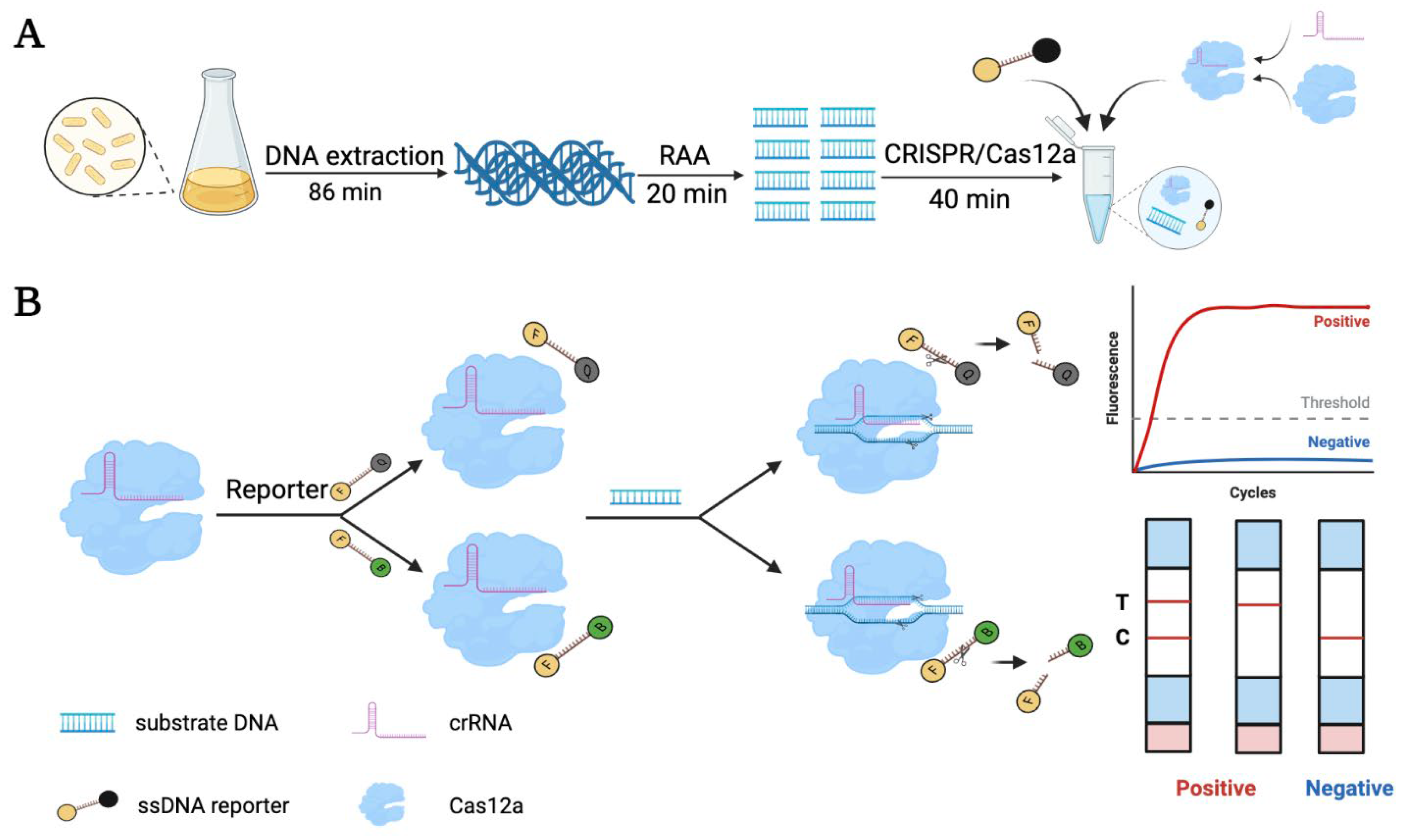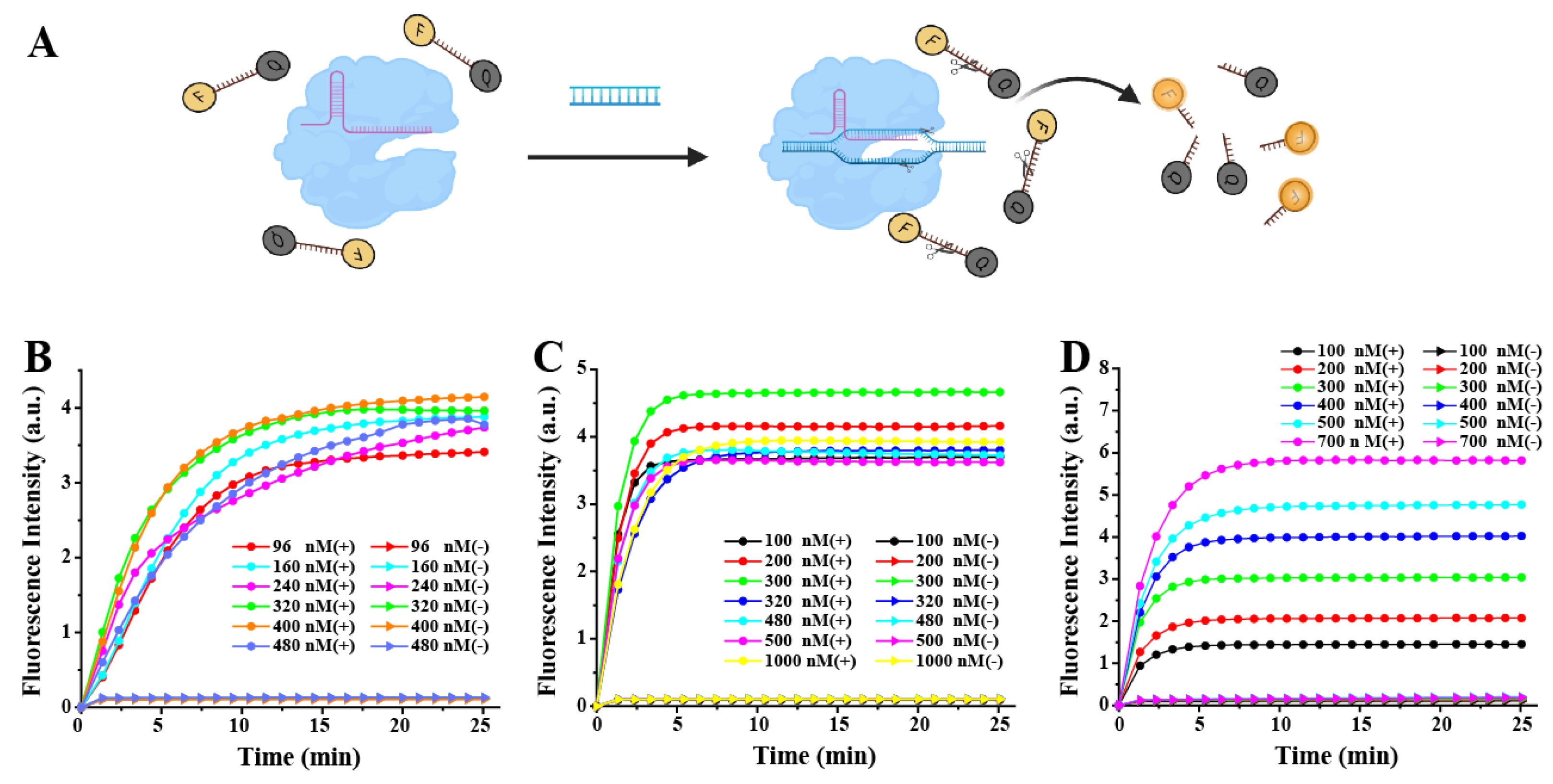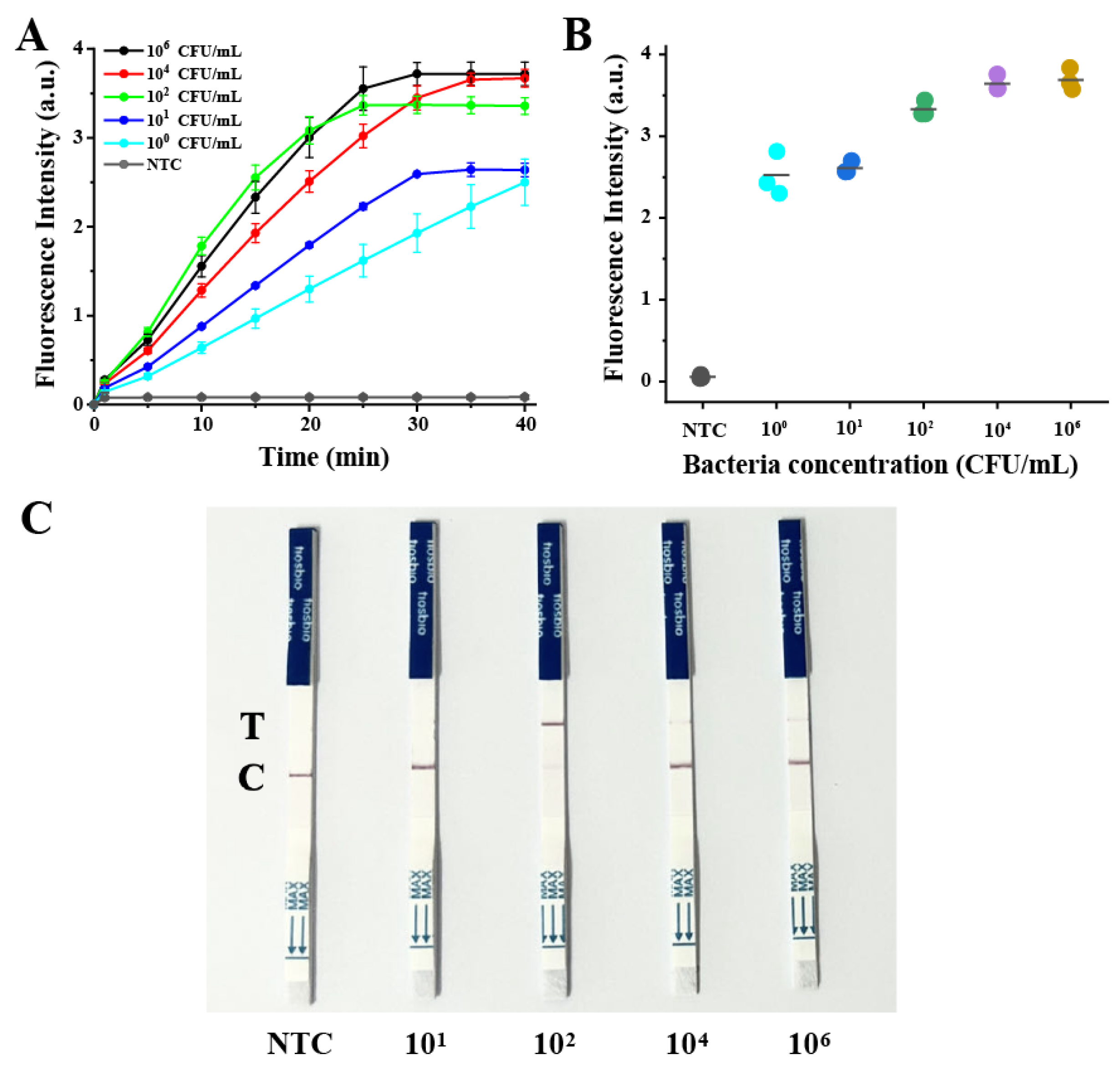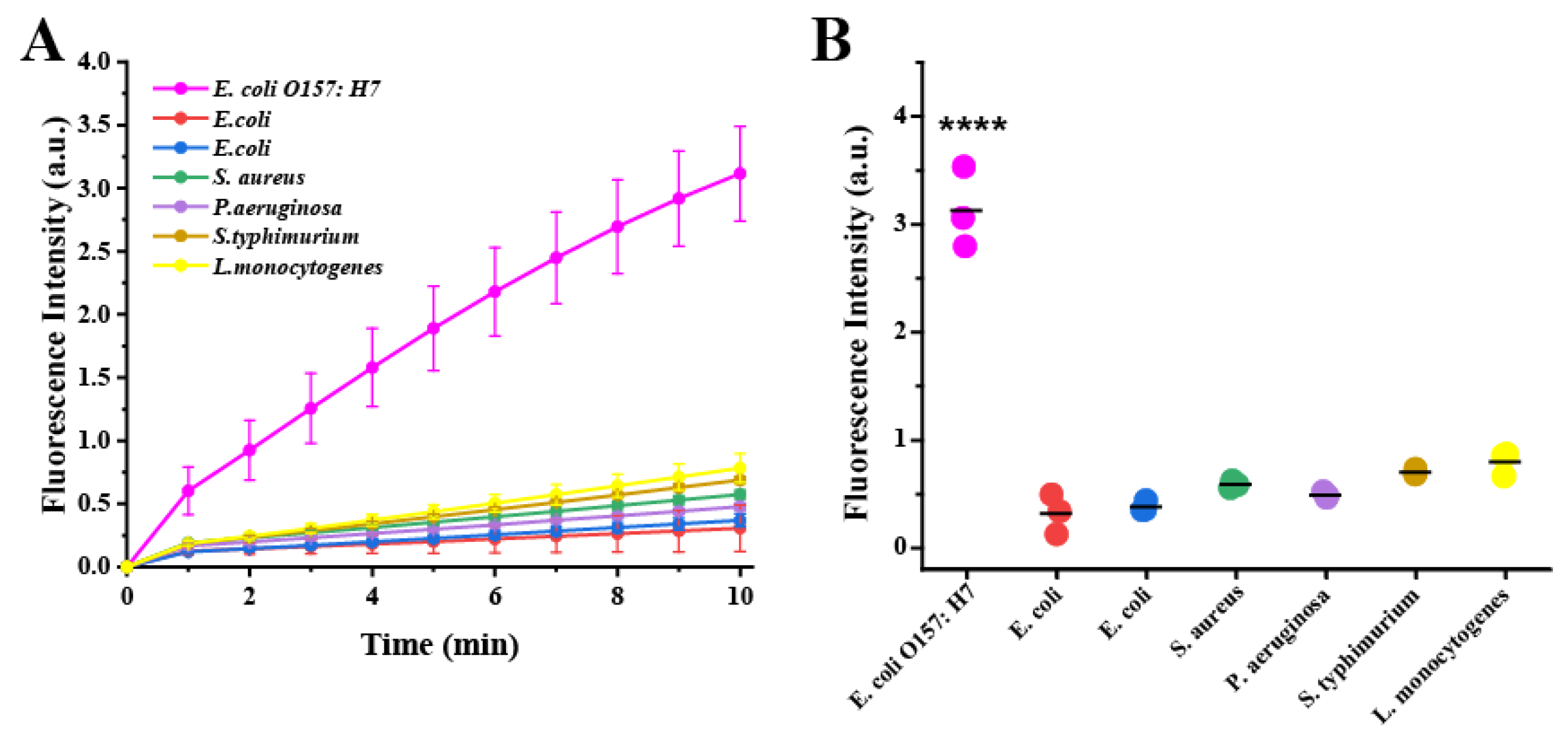Ultrasensitive and Rapid Visual Detection of Escherichia coli O157:H7 Based on RAA-CRISPR/Cas12a System
Abstract
1. Introduction
2. Materials and Methods
2.1. Materials and Apparatus
2.2. Bacterial Strains and Culture Conditions
2.3. Bacterial DNA Extraction
2.4. Isothermal Amplification
2.5. CRISPR/Cas12a Fluorescence Assay
2.6. CRISPR/Cas12a-LFA Assay
2.7. Sensitivity and Specificity Tests
2.8. Detection of E. coli O157:H7 in Milk and Drinking Water
2.9. Optimizing the Time Required for the Entire Detection Process
3. Results and Discussion
3.1. CRISPR/Cas12a-Based E. coli O157:H7 Genomic DNA Detection System
3.2. Optimization of the RAA-CRISPR/Cas12a Reaction System
3.3. Detection Sensitivity of the RAA-CRISPR/Cas12a System
3.4. Specificity of the CRISPR/Cas12a System for Detecting E. coli O157:H7
3.5. The Application Potential of the RAA-CRISPR/Cas12a System
4. Conclusions
Supplementary Materials
Author Contributions
Funding
Institutional Review Board Statement
Informed Consent Statement
Data Availability Statement
Conflicts of Interest
References
- Majowicz, S.E.; Scallan, E.; Jones-Bitton, A.; Sargeant, J.M.; Stapleton, J.; Angulo, F.J.; Yeung, D.H.; Kirk, M.D. Global Incidence of Human Shiga Toxin-Producing Escherichia coli Infections and Deaths: A Systematic Review and Knowledge Synthesis. Foodborne Pathog. Dis. 2014, 11, 447–455. [Google Scholar] [CrossRef] [PubMed]
- Allison, S.E.; Silphaduang, U.; Mascarenhas, M.; Konczy, P.; Quan, Q.; Karmali, M.; Coombes, B.K. Novel Repressor of Escherichia coli O157:H7 Motility Encoded in the Putative Fimbrial Cluster OI-1. J. Bacteriol. 2012, 194, 5343–5352. [Google Scholar] [CrossRef] [PubMed]
- Bian, X.; Jing, F.; Li, G.; Fan, X.; Jia, C.; Zhou, H.; Jin, Q.; Zhao, J. A Microfluidic Droplet Digital PCR for Simultaneous Detection of Pathogenic Escherichia coli O157 and Listeria Monocytogenes. Biosens. Bioelectron. 2015, 74, 770–777. [Google Scholar] [CrossRef] [PubMed]
- Chekabab, S.M.; Paquin-Veillette, J.; Dozois, C.M.; Harel, J. The Ecological Habitat and Transmission of Escherichia coli O157:H7. FEMS Microbiol. Lett. 2013, 341, 1–12. [Google Scholar] [CrossRef] [PubMed]
- Mead, P.S.; Griffin, P.M. Escherichia coli O157:H7. Lancet 1998, 352, 1207–1212. [Google Scholar] [CrossRef] [PubMed]
- Kaper, J.B.; Nataro, J.P.; Mobley, H.L.T. Pathogenic Escherichia coli. Nat. Rev. Microbiol. 2004, 2, 123–140. [Google Scholar] [CrossRef]
- Nataro, J.P.; Kaper, J.B. Diarrheagenic Escherichia coli. Clin. Microbiol. Rev. 1998, 11, 142–201. [Google Scholar] [CrossRef]
- Brunetti, G.; Conteduca, D.; Armenise, M.; Ciminelli, C. Novel Micro-Nano Optoelectronic Biosensor for Label-Free Real-Time Biofilm Monitoring. Biosensors 2021, 11, 361. [Google Scholar] [CrossRef] [PubMed]
- Di Toma, A.; Brunetti, G.; Chiriacò, M.S.; Ferrara, F.; Ciminelli, C. A Novel Hybrid Platform for Live/Dead Bacteria Accurate Sorting by On-Chip DEP Device. Int. J. Mol. Sci. 2023, 24, 7077. [Google Scholar] [CrossRef] [PubMed]
- Leva-Bueno, J.; Peyman, S.A.; Millner, P.A. A Review on Impedimetric Immunosensors for Pathogen and Biomarker Detection. Med. Microbiol. Immunol. 2020, 209, 343–362. [Google Scholar] [CrossRef] [PubMed]
- Pugia, M.; Bose, T.; Tjioe, M.; Frabutt, D.; Baird, Z.; Cao, Z.; Vorsilak, A.; McLuckey, I.; Barron, M.R.; Barron, M.; et al. Multiplexed Signal Ion Emission Reactive Release Amplification (SIERRA) Assay for the Culture-Free Detection of Gram-Negative and Gram-Positive Bacteria and Antimicrobial Resistance Genes. Anal. Chem. 2021, 93, 6604–6612. [Google Scholar] [CrossRef] [PubMed]
- Adams, A.N.; Clark, M.F. Characteristics of the Microplate Method of Enzyme-Linked Immunosorbent Assay for the Detection of Plant Viruses. J. Gen. Virol. 1977, 34, 475–483. [Google Scholar]
- Klein, D. Quantification Using Real-Time PCR Technology: Applications and Limitations. Trends Mol. Med. 2002, 8, 257–260. [Google Scholar] [CrossRef] [PubMed]
- Lei, S.; Gu, X.; Zhong, Q.; Duan, L.; Zhou, A. Absolute Quantification of Vibrio Parahaemolyticus by Multiplex Droplet Digital PCR for Simultaneous Detection of Tlh, Tdh and UreR Based on Single Intact Cell. Food Control 2020, 114, 107207. [Google Scholar] [CrossRef]
- March, S.B.; Ratnam, S. Sorbitol-MacConkey Medium for Detection of Escherichia coli O157:H7 Associated with Hemorrhagic Colitis. J. Clin. Microbiol. 1986, 23, 869–872. [Google Scholar] [CrossRef] [PubMed]
- Boonham, N.; Kreuze, J.; Winter, S.; van der Vlugt, R.; Bergervoet, J.; Tomlinson, J.; Mumford, R. Methods in Virus Diagnostics: From ELISA to next Generation Sequencing. Virus Res. 2014, 186, 20–31. [Google Scholar] [CrossRef] [PubMed]
- Lim, M.-C.; Lee, G.-H.; Huynh, D.T.N.; Hong, C.-E.; Park, S.-Y.; Jung, J.-Y.; Park, C.-S.; Ko, S.; Kim, Y.-R. Biological Preparation of Highly Effective Immunomagnetic Beads for the Separation, Concentration, and Detection of Pathogenic Bacteria in Milk. Colloids Surf. B Biointerfaces 2016, 145, 854–861. [Google Scholar] [CrossRef]
- Yu, J.; Su, J.; Zhang, J.; Wei, X.; Guo, A. CdTe/CdS Quantum Dot-Labeled Fluorescent Immunochromatography Test Strips for Rapid Detection of Escherichia coli O157:H7. RSC Adv. 2017, 7, 17819–17823. [Google Scholar] [CrossRef]
- Huang, Z.; Peng, J.; Han, J.; Zhang, G.; Huang, Y.; Duan, M.; Liu, D.; Xiong, Y.; Xia, S.; Lai, W. A Novel Method Based on Fluorescent Magnetic Nanobeads for Rapid Detection of Escherichia coli O157:H7. Food Chem. 2019, 276, 333–341. [Google Scholar] [CrossRef]
- Brakstad, O.G.; Aasbakk, K.; Maeland, J.A. Detection of Staphylococcus Aureus by Polymerase Chain Reaction Amplification of the Nuc Gene. J. Clin. Microbiol. 1992, 30, 1654–1660. [Google Scholar] [CrossRef]
- Macori, G.; McCarthy, S.C.; Burgess, C.M.; Fanning, S.; Duffy, G. A Quantitative Real Time PCR Assay to Detect and Enumerate Escherichia coli O157 and O26 Serogroups in Sheep Recto-Anal Swabs. J. Microbiol. Methods 2019, 165, 105703. [Google Scholar] [CrossRef] [PubMed]
- Fu, Z.; Rogelj, S.; Kieft, T.L. Rapid Detection of Escherichia coli O157:H7 by Immunomagnetic Separation and Real-Time PCR. Int. J. Food Microbiol. 2005, 99, 47–57. [Google Scholar] [CrossRef]
- Jofré, A.; Martin, B.; Garriga, M.; Hugas, M.; Pla, M.; Rodríguez-Lázaro, D.; Aymerich, T. Simultaneous Detection of Listeria Monocytogenes and Salmonella by Multiplex PCR in Cooked Ham. Food Microbiol. 2005, 22, 109–115. [Google Scholar] [CrossRef]
- Donhauser, S.C.; Niessner, R.; Seidel, M. Quantification of E. coli DNA on a Flow-through Chemiluminescence Microarray Readout System after PCR Amplification. Anal. Sci. 2009, 25, 669–674. [Google Scholar] [CrossRef]
- Doudna, J.A.; Charpentier, E. The New Frontier of Genome Engineering with CRISPR-Cas9. Science 2014, 346, 1258096. [Google Scholar] [CrossRef]
- Knott, G.J.; Doudna, J.A. CRISPR-Cas Guides the Future of Genetic Engineering. Science 2018, 361, 866–869. [Google Scholar] [CrossRef] [PubMed]
- Samanta, D.; Ebrahimi, S.B.; Ramani, N.; Mirkin, C.A. Enhancing CRISPR-Cas-Mediated Detection of Nucleic Acid and Non-Nucleic Acid Targets Using Enzyme-Labeled Reporters. J. Am. Chem. Soc. 2022, 144, 16310–16315. [Google Scholar] [CrossRef] [PubMed]
- Bonini, A.; Poma, N.; Vivaldi, F.; Biagini, D.; Bottai, D.; Tavanti, A.; Di Francesco, F. A Label-Free Impedance Biosensing Assay Based on CRISPR/Cas12a Collateral Activity for Bacterial DNA Detection. J. Pharm. Biomed. Anal. 2021, 204, 114268. [Google Scholar] [CrossRef] [PubMed]
- Sun, X.; Wang, Y.; Zhang, L.; Liu, S.; Zhang, M.; Wang, J.; Ning, B.; Peng, Y.; He, J.; Hu, Y.; et al. CRISPR-Cas9 Triggered Two-Step Isothermal Amplification Method for E. coli O157:H7 Detection Based on a Metal–Organic Framework Platform. Anal. Chem. 2020, 92, 3032–3041. [Google Scholar] [CrossRef] [PubMed]
- Kadam, U.S.; Cho, Y.; Park, T.Y.; Hong, J.C. Aptamer-Based CRISPR-Cas Powered Diagnostics of Diverse Biomarkers and Small Molecule Targets. Appl. Biol. Chem. 2023, 66, 13. [Google Scholar] [CrossRef] [PubMed]
- Barrangou, R.; Fremaux, C.; Deveau, H.; Richards, M.; Boyaval, P.; Moineau, S.; Romero, D.A.; Horvath, P. CRISPR Provides Acquired Resistance Against Viruses in Prokaryotes. Science 2007, 315, 1709–1712. [Google Scholar] [CrossRef]
- Wang, Y.; Ke, Y.; Liu, W.; Sun, Y.; Ding, X. A One-Pot Toolbox Based on Cas12a/CrRNA Enables Rapid Foodborne Pathogen Detection at Attomolar Level. ACS Sens. 2020, 5, 1427–1435. [Google Scholar] [CrossRef]
- Wang, S.; Fan, Y.; Feng, Z.; Song, M.; Li, Q.; Jiang, B.; Qin, F.; Liu, H.; Lan, L.; Yang, M. Rapid Nucleic Acid Detection of Escherichia coli O157:H7 Based on CRISPR/Cas12a System. Food Control 2021, 130, 108194. [Google Scholar] [CrossRef]
- Liu, L.; Duan, J.-J.; Wei, X.-Y.; Hu, H.; Wang, Y.-B.; Jia, P.-P.; Pei, D.-S. Generation and Application of a Novel High-Throughput Detection Based on RPA-CRISPR Technique to Sensitively Monitor Pathogenic Microorganisms in the Environment. Sci. Total Environ. 2022, 838, 156048. [Google Scholar] [CrossRef]
- Li, F.; Ye, Q.; Chen, M.; Xiang, X.; Zhang, J.; Pang, R.; Xue, L.; Wang, J.; Gu, Q.; Lei, T.; et al. Cas12aFDet: A CRISPR/Cas12a-Based Fluorescence Platform for Sensitive and Specific Detection of Listeria Monocytogenes Serotype 4c. Anal. Chim. Acta 2021, 1151, 338248. [Google Scholar] [CrossRef]
- Feng, W.; Newbigging, A.M.; Tao, J.; Cao, Y.; Peng, H.; Le, C.; Wu, J.; Pang, B.; Li, J.; Tyrrell, D.L.; et al. CRISPR Technology Incorporating Amplification Strategies: Molecular Assays for Nucleic Acids, Proteins, and Small Molecules. Chem. Sci. 2021, 12, 4683–4698. [Google Scholar] [CrossRef] [PubMed]
- Zhang, M.; Wang, H.; Wang, H.; Wang, F.; Li, Z. CRISPR/Cas12a-Assisted Ligation-Initiated Loop-Mediated Isothermal Amplification (CAL-LAMP) for Highly Specific Detection of MicroRNAs. Anal. Chem. 2021, 93, 7942–7948. [Google Scholar] [CrossRef] [PubMed]
- Yang, B.; Shi, Z.; Ma, Y.; Wang, L.; Cao, L.; Luo, J.; Wan, Y.; Song, R.; Yan, Y.; Yuan, K.; et al. LAMP Assay Coupled with CRISPR/Cas12a System for Portable Detection of African Swine Fever Virus. Transbound. Emerg. Dis. 2022, 69, e216–e223. [Google Scholar] [CrossRef] [PubMed]
- Chang, W.; Liu, W.; Liu, Y.; Zhan, F.; Chen, H.; Lei, H.; Liu, Y. Colorimetric Detection of Nucleic Acid Sequences in Plant Pathogens Based on CRISPR/Cas9 Triggered Signal Amplification. Microchim. Acta 2019, 186, 243. [Google Scholar] [CrossRef]
- Zhang, Y.; Chen, M.; Liu, C.; Chen, J.; Luo, X.; Xue, Y.; Liang, Q.; Zhou, L.; Tao, Y.; Li, M.; et al. Sensitive and Rapid On-Site Detection of SARS-CoV-2 Using a Gold Nanoparticle-Based High-Throughput Platform Coupled with CRISPR/Cas12-Assisted RT-LAMP. Sens. Actuators B Chem. 2021, 345, 130411. [Google Scholar] [CrossRef]
- Xiang, X.; Li, F.; Ye, Q.; Shang, Y.; Chen, M.; Zhang, J.; Zhou, B.; Suo, H.; Ding, Y.; Wu, Q. High-throughput Microfluidic Strategy Based on RAA-CRISPR/Cas13a Dual Signal Amplification for Accurate Identification of Pathogenic Listeria. Sens. Actuators B Chem. 2022, 358, 131517. [Google Scholar] [CrossRef]
- Liu, L.; Zhao, G.; Li, X.; Xu, Z.; Lei, H.; Shen, X. Development of Rapid and Easy Detection of Salmonella in Food Matrics Using RPA-CRISPR/Cas12a Method. LWT Food Sci. Technol. 2022, 162, 113443. [Google Scholar] [CrossRef]
- Ibekwe, A.M.; Watt, P.M.; Grieve, C.M.; Sharma, V.K.; Lyons, S.R. Multiplex Fluorogenic Real-Time PCR for Detection and Quantification of Escherichia coli O157:H7 in Dairy Wastewater Wetlands. Appl. Environ. Microbiol. 2002, 68, 4853–4862. [Google Scholar] [CrossRef] [PubMed]
- Ibekwe, A.M.; Grieve, C.M. Detection and Quantification of Escherichia coli O157:H7 in Environmental Samples by Real-Time PCR. J. Appl. Microbiol. 2003, 94, 421–431. [Google Scholar] [CrossRef] [PubMed]
- Zhou, R.; Li, Y.; Dong, T.; Tang, Y.; Li, F. A Sequence-Specific Plasmonic Loop-Mediated Isothermal Amplification Assay with Orthogonal Color Readouts Enabled by CRISPR Cas12a. Chem. Commun. 2020, 56, 3536–3538. [Google Scholar] [CrossRef] [PubMed]
- Feng, M.; Yong, Q.; Wang, W.; Kuang, H.; Wang, L.; Xu, C. Development of a Monoclonal Antibody-Based ELISA to Detect Escherichia coli O157:H7. Food Agric. Immunol. 2013, 24, 481–487. [Google Scholar] [CrossRef]
- Pang, B.; Zhao, C.; Li, L.; Song, X.; Xu, K.; Wang, J.; Liu, Y.; Fu, K.; Bao, H.; Song, D.; et al. Development of a Low-Cost Paper-Based ELISA Method for Rapid Escherichia coli O157:H7 Detection. Anal. Biochem. 2018, 542, 58–62. [Google Scholar] [CrossRef]
- Shen, Z.; Hou, N.; Jin, M.; Qiu, Z.; Wang, J.; Zhang, B.; Wang, X.; Wang, J.; Zhou, D.; Li, J. A Novel Enzyme-Linked Immunosorbent Assay for Detection of Escherichia coli O157:H7 Using Immunomagnetic and Beacon Gold Nanoparticles. Gut Pathog. 2014, 6, 14. [Google Scholar] [CrossRef]
- Jung, B.Y.; Jung, S.C.; Kweon, C.H. Development of a Rapid Immunochromatographic Strip for Detection of Escherichia coli O157. J. Food Prot. 2005, 68, 2140–2143. [Google Scholar] [CrossRef]





Disclaimer/Publisher’s Note: The statements, opinions and data contained in all publications are solely those of the individual author(s) and contributor(s) and not of MDPI and/or the editor(s). MDPI and/or the editor(s) disclaim responsibility for any injury to people or property resulting from any ideas, methods, instructions or products referred to in the content. |
© 2023 by the authors. Licensee MDPI, Basel, Switzerland. This article is an open access article distributed under the terms and conditions of the Creative Commons Attribution (CC BY) license (https://creativecommons.org/licenses/by/4.0/).
Share and Cite
Zhu, L.; Liang, Z.; Xu, Y.; Chen, Z.; Wang, J.; Zhou, L. Ultrasensitive and Rapid Visual Detection of Escherichia coli O157:H7 Based on RAA-CRISPR/Cas12a System. Biosensors 2023, 13, 659. https://doi.org/10.3390/bios13060659
Zhu L, Liang Z, Xu Y, Chen Z, Wang J, Zhou L. Ultrasensitive and Rapid Visual Detection of Escherichia coli O157:H7 Based on RAA-CRISPR/Cas12a System. Biosensors. 2023; 13(6):659. https://doi.org/10.3390/bios13060659
Chicago/Turabian StyleZhu, Lishan, Zhenda Liang, Yongtao Xu, Zhiquan Chen, Jiasi Wang, and Li Zhou. 2023. "Ultrasensitive and Rapid Visual Detection of Escherichia coli O157:H7 Based on RAA-CRISPR/Cas12a System" Biosensors 13, no. 6: 659. https://doi.org/10.3390/bios13060659
APA StyleZhu, L., Liang, Z., Xu, Y., Chen, Z., Wang, J., & Zhou, L. (2023). Ultrasensitive and Rapid Visual Detection of Escherichia coli O157:H7 Based on RAA-CRISPR/Cas12a System. Biosensors, 13(6), 659. https://doi.org/10.3390/bios13060659





